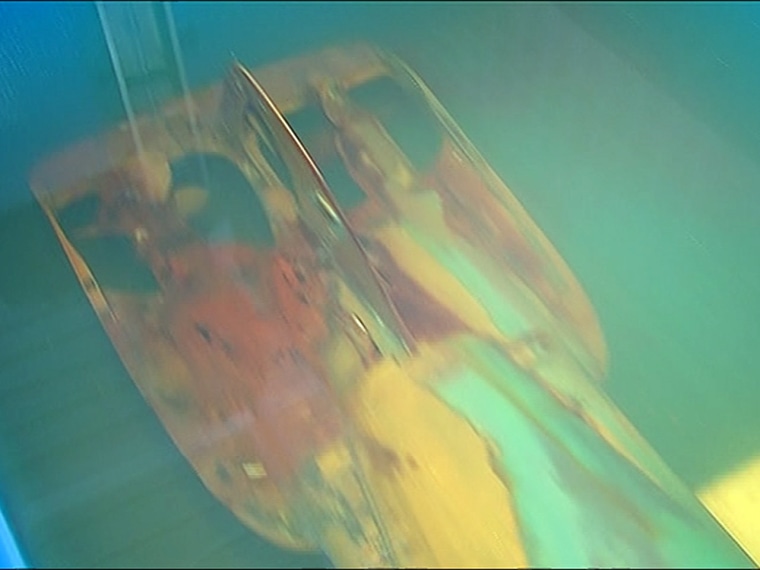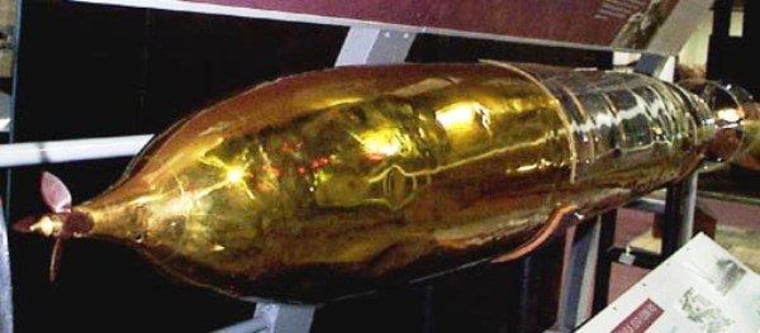
The U.S. Navy doesn't yet exactly know how a 130-year-old brass torpedo got to the bottom of the Pacific off the coast of San Diego, but they have a couple of dolphins to thank for rediscovering the rare weapon.
The find was so unexpected that the humans didn't believe the dolphins at first.
The marine mammals have been trained by the Navy's Space and Navy Warfare Systems Center Pacific, or SSC Pacific, to hunt for underwater mines and mark their locations. Divers place mine-shaped objects on the sea bottom, and then they teach the dolphins to find them. "It's all part of training to show the dolphins what they're going to be exposed to when they're on real-world missions," SSC Pacific spokesman Jim Fallin told NBC News on Monday.
During an exercise in March, conducted not far from California's historic Hotel del Coronado, the trainers sent a dolphin down to look for the pre-positioned target objects. The dolphin dove down, came back up — and gave the trainers a signal they didn't expect. "It had found something where we knew something shouldn't be," Fallin said.
The training team dismissed that first signal as a false positive. But when the same team went back to the same place with a different dolphin, the location was flagged again, Fallin said. That's when the trainers started taking the animals seriously.
A piece of naval history
SSC Pacific worked with recovery divers and bomb disposal experts to check out what the dolphins had found. At first, they thought the object was merely an old tail section from an aerial drop mine. They quickly changed their minds.
"It was apparent in the first 15 minutes that this was something that was significant and really old," Christian Harris, operations supervisor for the SSC Pacific Biosciences Division, said in a news release. It turned out to be the tail section from one of the first self-propelled torpedoes developed and used by the U.S. Navy, known as the Howell torpedo.


More sections were brought up and submerged in water for preservation. Eventually the torpedo will be flown to the Naval History and Heritage Command at the Washington Navy Yard for more thorough study. "What's missing at this point is the nose, and we're not sure where that is," Fallin said.
The 11-foot-long (3.4-meter-long) torpedo was developed by Lt. Cmdr. John A. Howell between 1870 and 1889. The Navy says it was driven by a 132-pound (60-kilogram) flywheel that was spun up to 10,000 rpm prior to launch. It had a range of 400 yards, a speed of 25 knots, and a warhead filled with 100 pounds of gun cotton.
"It was the first torpedo that could be released into the ocean and follow a track," Harris said. "Considering that it was made before electricity was provided to U.S. households, it was pretty sophisticated for its time."
Howell torpedoes were used on Navy battleships and torpedo boats until 1898, when they were replaced by Whitehead torpedoes. Only 50 of the Howells were ever were built. The only other Howell that exists today is sitting inert in the Naval Undersea Museum in Keyport, Wash.
How did the torpedo get there? Fallin said he "can't add any information other than that it was there," he said.
Day of the dolphins
This isn't the first unexpected object located by the Navy's mine-hunting dolphins: Previously, the mammals have detected sunken items including a submerged car and a lobster trap in a place "where a lobster trap wasn't supposed to be," Fallin said. But the Howell torpedo could well rank as the most significant archaeological find for a finny troop that's trained for war.
The dolphins' finest hour came during the Persian Gulf conflicts, when they spotted underwater hazards and served as sentries for the U.S-led coalition's vessels.
"Dolphins remain the pre-eminent capability for the Navy in counter-mine identification," Fallin said. "There's no technology that the Navy has today that replicates the dolphins' natural ability to identify mines ... although our lab is working on those futuristic technologies. We're designing those technologies around the sonar capabilities that are inherent in dolphins. Unmanned autonomous robots have been proven to be pretty capable at this point in shallow water. The technology holds promise."
It's all in a day's work for the dolphins — and for SSC Pacific, an arm of the Navy's Space and Naval Warfare Systems Command that focuses on command and control, communications, computers, intelligence, surveillance and reconnaissance — a group of technologies known as C4ISR. "We represent the nation's only full-spectrum C4ISR laboratory," Fallin said.
More about dolphins intelligence:
- Dolphins appear to do nonlinear mathematics
- Are dolphins the world's second-smartest animals?
- Dolphins sought to protect against terrorists
Alan Boyle is NBCNews.com's science editor. Connect with the Cosmic Log community by "liking" the NBC News Science Facebook page, following @b0yle on Twitter and adding the Cosmic Log page to your Google+ presence. To keep up with NBCNews.com's stories about science and space, sign up for the Tech & Science newsletter, delivered to your email in-box every weekday. You can also check out "The Case for Pluto," my book about the controversial dwarf planet and the search for new worlds.